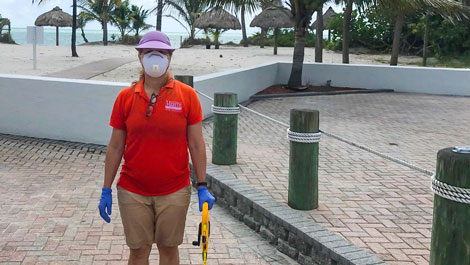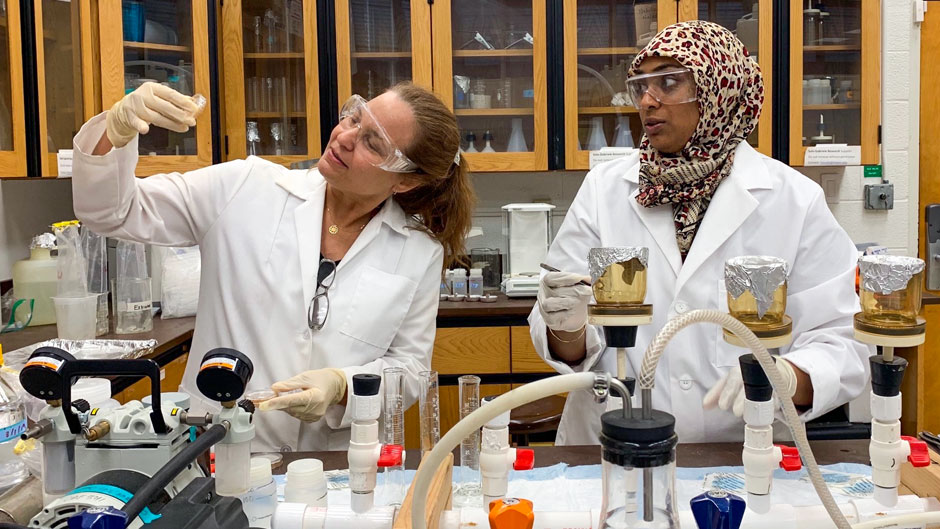Armed with plastic collection bags and sand scoopers, Helena Solo-Gabriele has been trying to get to the bottom of an environmental conundrum for months: What is the source of the unusually high levels of enterococci bacteria that have been contaminating the waters of Key Biscayne Beach?
Residents had long pointed the finger at a wastewater treatment plant on neighboring Virginia Key, but Solo-Gabriele, a professor of environmental engineering at the University of Miami College of Engineering, always had her doubts, theorizing that something just offshore was to blame.
Now, a public health measure implemented to help stop the spread of the novel coronavirus may have proved the researcher and her team of graduate assistants right.
“Millions of people visit Florida beaches every year, so we always suspected that the source of contamination was coming from beachgoers,” Solo-Gabriele explained. “Our bodies are constantly shedding bacteria either through the skin or via other avenues, and we speculated that a lot of the contamination was being caused by that process—people shedding while they’re in the water or shedding straight into the sand and seaweed.”
And sand and sea, said Afeefa Abdool-Ghany, an environmental engineering graduate student who has been working closely with Solo-Gabriele, can be ideal incubators for enterococci bacteria, allowing it to grow and eventually be carried out to deeper water by high tides.

In lab tests conducted on water, sand, and seaweed samples collected from Key Biscayne Beach before it closed in accordance with COVID-19 shutdowns, Abdool-Ghany and Solo-Gabriele measured levels of enterococci bacteria in excess of 1,000 colony forming units (CFUs) per gram. But in lab samples collected days after beach closures went into effect, those levels dropped considerably—to less than 1 CFU per gram, according to the researchers.
“We were astonished,” said Solo-Gabriele, who has been conducting the tests as part of a Village of Key Biscayne-funded study to test beach waters for potentially dangerous microbes. “The sand and seaweed were amazingly high in bacteria levels before COVID. Then, shortly after the shutdowns, the levels dropped dramatically. We’ve run the tests twice, and it’s been consistent.”
Solo-Gabriele has obtained special permission from the University, the Florida Department of Health in Miami-Dade County, and the Village of Key Biscayne to collect the samples while the beach is closed. Maribeth Gidley, a research scientist at the University of Miami’s Cooperative Institute for Marine and Atmospheric Studies, and James Klaus, an associate professor of marine geosciences at the Rosenstiel School of Marine and Atmospheric Science, are collaborating with Solo-Gabriele on the study.
“Once the beaches come back online, it’ll be interesting to see whether or not the bacteria come back,” Solo-Gabriele said.
If the bacteria are ingested while swimming, it can cause gastrointestinal disease and other infections. Studies have also shown that enterococci correlate with microbes that cause skin rashes. So, Solo-Gabriele recommends beachgoers practice good hygiene such as handwashing and showering, especially amid the ongoing pandemic.
Her team is certain the nearby wastewater treatment plant on Virginia Key is not the culprit. “In our study, we found that the plant has been operating effectively as it should, so it couldn’t be the source of contamination,” Abdool-Ghany said.
Solo-Gabriele also is conducting microbial source tracking on the samples, with the intent of obtaining a DNA fingerprint of the bacteria to determine if other sources, such as birdlife and dogs, are contributing to the contamination. But that testing is currently delayed because the National Oceanic and Atmospheric Administration laboratory, where it will be conducted, is currently closed.
COVID-19 will present unprecedented opportunities for research in her field, Solo-Gabriele said, noting that the virus has been detected in stool. “So, it’s collecting in our city sewers,” she noted. One company, she added, is testing sewage from across the nation, hoping to provide geographical information on the virus in communities.
Solo-Gabriele plans to continue her Key Biscayne Beach sampling study for up to five weeks after the beach reopens.

